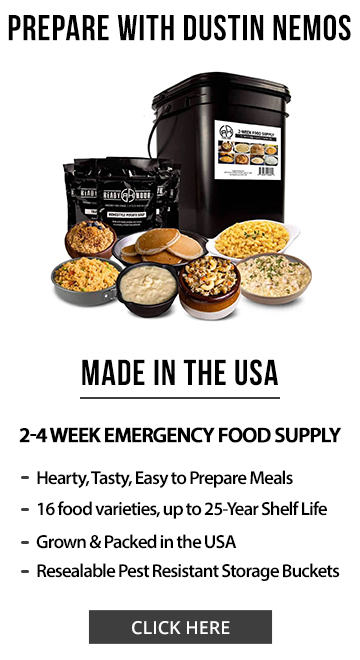Via The Epoch Times (emphasis ours),
Editor’s Note:

Ever gone out to an inexpensive buffet and marveled at the vast display of freshly prepared, hot food just waiting to be devoured? You choose the perfectly fried tempura shrimp—that unbeknownst to you—may have been mixed with a binding enzyme called transglutaminase—otherwise known as meat glue. This is not an unlikely scenario as meat glue—though banned in the European Union—is classified by the U.S. Food and Drug Administration as “generally recognized as safe.”
In the book, “A Consumer’s Guide to Toxic Food Additives” authors Bill and Linda Bonvie reveal the many additives lurking in our everyday food and outline ways we can identify and eliminate them from our diets. Following on the heels of our excerpt about the health implications of carrageenan, this one is sure to “stick” in your mind.

Meat Glue—Pink Slime’s Far More Sickening Sibling
Back in 2012, an ABC news lead story about Pink Slime (called in the industry by the more appetizing name, “finely textured beef”) struck a chord of disgust in the meat-eating public.
Petitions were formed to get the product out of the school lunch program, and celebrity chef Jamie Oliver conducted pink slime demos where he put beef scraps in a washing machine and then soaked them in ammonia and water.
Right before the slime hit the fan, however, ABC news affiliates spilled the beans about another underground meat practice. It was the use of an enzyme called transglutaminase, or, as it’s more commonly referred to, meat glue.
Now, even though meat glue has the potential to be a lot more hazardous to your health than pink slime, for some reason, the public couldn’t quite seem to wrap its head around it in the same way.
While some stories appeared in the press at the time, there were no petitions or consumers calling on the FDA or USDA to do something about it. In fact, some big-name chefs even came out in praise of meat glue.
For example, Wylie Dufresne, who was both chef and owner of the super-pricy Manhattan eatery wd~50 (which closed in 2014), was quoted in Meat Paper as saying he had “concocted all manner of playful and bizarre food products with meat glue, including shrimp spaghetti, which he made by mixing salt, cayenne, deveined shrimp, and meat glue in a blender.”
“Meat glue,” Dufresne declared, “makes us better chefs.”
However, even if you’re dining at an elegant establishment like wd~50, you may want to think twice about eating “glued” food. That’s one of the problems with this stuff—the appearance of food in which it has been used can definitely be deceiving.
How to Fake a Steak (or Eggs)
Since 2016, a certain restaurant chain has been using the catchy slogan “You can’t fake steak” in its TV commercials. While we can’t say whether or not that particular chain’s steaks are the real McCoy, the fact is that the slogan is wrong: You can indeed fake steak—by simply using a little meat glue.
At one time, transglutaminase was manufactured entirely from the clotting agent extracted from pig or cow’s blood. Now, it’s typically made by cultivating bacteria to do the job. Most of the meat glue supplied to the food industry comes from none other than Ajinomoto—the company that brought MSG to America.
Like MSG, Ajinomoto claims that transglutaminase is “ubiquitous in nature … typically found in various plants and animals.” Where MSG is concerned, that premise really doesn’t hold much water, as “bound” glutamic acid found in things such as meat, mushrooms, or tomatoes is quite different than the free glutamic acid added to food. Now, new research has found that this might also apply to transglutaminase sprinkled on meat or seafood.
What meat glue does is to allow restaurants and manufacturers to get away with one of the most devious forms of food fakery. Even the meat industry, when it defends transglutaminase, has to acknowledge that it can be used to fool diners. Meat glue is used much more often to “fake a steak” than to make gourmet shrimp noodles, as chef Dufresne did. By sprinkling the enzyme on various scrap pieces of meat, chicken, or seafood, and then binding it tightly in plastic wrap and refrigerating it for several hours, you can turn out a picture-perfect filet mignon, solid piece of chicken, or a top-dollar-looking filet of fish.
Even experts can’t tell the difference.
If you’ve ever attended a banquet or a convention, or maybe even dined in a restaurant, and were served an expensive-looking steak or sushi at a bargain price, you may have wondered how that came to be. The answer is either that the restaurant owner is losing money with each meal or, more likely, that there’s a bag of meat glue in the kitchen.
The fake food industry has also found use for meat glue in a product bizarrely called “JUST Egg,” something that contains no trace of eggs. But along with brain-damaging amino acids, you will find transglutaminase listed on the JUST Egg label—yet another excellent reason to read food ingredients carefully no matter what brand names the products are given.

A Pathway for Pathogens to Get Inside Your Dinner
Fakery aside, meat glue could be contributing to the growing epidemic of food poisoning that hits millions (the CDC puts the number at 1 in 6 Americans or around 48 million every year).
That’s because pathogens, like Escherichia coli, Listeria, and Salmonella (with many strains now antibiotic resistant) mostly appear on the surface of meat. When the outer surface is seared, even if the meat is eaten medium rare or rare, that bacteria have most likely been killed.
When multiple pieces of meat are combined, however, those pathogens could be lurking in the center. Surfaces of the meat that once were on the outside are now in the middle. If you haven’t cooked that meat thoroughly inside and out, you could be in for big trouble.
On an Australian TV exposé of meat glue several years ago, an expert in microbiology commented that “the amount of bacteria on a steak that’s been put together with meat glue is hundreds of times higher” than your average piece of unglued meat. The same is true for chicken and fish.
Now, if you ask the FDA [U.S. Food and Drug Administration], USDA [U.S. Department of Agriculture], and certainly Ajinomoto, you’re going to hear that meat glue is perfectly safe. Sure, there’s that little problem of bacterial contamination, but these US consumer protection agencies appear to be quite confident that restaurants know that glued meat needs to be cooked thoroughly.
The USDA calls it TG enzyme, and gives instructions for cooking stuck-together meat that sounds exactly the same as what it would tell you about cooking all types of raw meat. As far as the FDA is concerned, there’s really no problem with Ajinomoto making its own determination that transglutaminase is generally recognized as safe, or GRAS.
Back in the late 1990s, the USDA received several petitions from both Ajinomoto and another company called AMPC about expanding the use of TG enzyme and attempting to get the consumer labeling (in the supermarket) to be as innocuous as possible.
Both companies got just about everything they wanted. Meat glue can now be used in meat products across the board—both the kind the USDA calls “standardized” and “non-standardized.” (This refers to what’s called a “standard of identity”—a legal description of what it takes for certain foods to be able to use a name such as hot dogs, milk, cheese, bread, etc. For example, if you want to sell something called “Salisbury steak,” it must contain at least 65 percent meat, among other requirements.)
In the case of meat glue, the agency had to change the standard of identity for numerous items like breakfast sausages, frankfurters, and bologna in order to allow for the use of the enzyme. Additionally, it was also approved to be used as a “binder” (something added to food to thicken or improve texture) for “certain meat and poultry products.”
As a result, it’s quite possible that manufacturers are putting it to uses way beyond faking expensive cuts of meat.
Perhaps one of the most important reasons you need to go out of your way to avoid this badditive has to do with a more recent discovery—one that might help explain the explosion of gut and digestive troubles that are plaguing so many these days.
The Role of Meat Glue in ‘Tight Junction Dysfunction’
In 2015, researchers from Israel and Germany published a study on how “industrial food additives” could be the cause of the “rising incidence of autoimmune disease.”
Autoimmune diseases (when the body launches an attack on itself) have shown “strong evidence of a steady rise” in Western cultures over the last thirty years, the authors said. Cases of diseases such as Type 1 diabetes, multiple sclerosis, Crohn’s disease, lupus, and rheumatic and celiac diseases are climbing every year.
According to the researchers, these illnesses can be due to something called “tight junction dysfunction.” Tight junctions refer to the “barrier and the fence” formed by connected cell membranes. When this finely tuned barrier is disrupted, it can set the stage for a wide variety of serious ailments.
The study, conducted by Professor Aaron Lerner and Dr. Torsten Matthias, called out transglutaminase as one of the commonly used food additives that can disrupt this internal barrier and enhance “intestinal junction leakage.”
Additionally, like manufactured glutamic acid (MSG), the authors pointed out that TG enzyme is quite different from the transglutaminase found naturally in the human body. Its use in the food industry, they warn, is also expanding on a “great scale.”
Celiac disease sufferers in particular, who are no doubt taking pains to avoid foods containing gluten, should also be aware of what these researchers believe is a link between their condition and meat glue, which may possibly explain the surge in celiac disease. “Several observations have led to the hypothesis that microbial transglutaminase is a new environmental enhancer of celiac disease,” they noted in a 2015 report, explaining how the substance may affect the immune system and promote intestinal leakage, allowing “more immunogenic foreign molecules to induce celiac disease.”
“If future research substantiates this hypothesis,” they wrote, “the findings will affect food product labeling, food additive policies of the food industry, and consumer health education.”
In the meantime, however, consumers will remain on their own when it comes to protecting their health from this hazardous adhesive addition to their favorite dish—especially when dining out (and out of sight of what’s being done in the kitchen).
Know Your Badditives and How to Avoid Them: Meat Glue (Transglutaminase)
- When dining out, watch out for menu items that are priced so low they seem too good to be true—because they probably are. If you’re attending a conference or convention, that rib-eye steak they’re serving up may very well have been scraps of meat the day before (Remember: restaurants have no requirements for any kind of labels or warnings, so you pretty much have to trust the integrity of whatever establishment you patronize).
-
Avoid buffet or supermarket “sushi.” Good (and safe) sushi is an expensive and very skilled dish to prepare, but ersatz versions may well be put together with meat glue.
-
If you’re buying prepared meat, chicken, or seafood in the supermarket (either frozen or made into an entrée), check for either transglutaminase on the ingredient list or the words “formed” or “reformed” on the packaging. Don’t expect to see any notice of this on the Nutrition Facts panel, which, in fact, is a very poor source of information about processed foods.
As transglutaminase is now appearing in new products, such as the fake food called “JUST Egg,” it’s obvious that the industry is finding more and more uses for it—another reason why reading the ingredients label on any processed food is not just a good idea, but a necessity.
Linda and Bill Bonvie are sibling journalists who have spent more than two decades writing about food safety and environmental issues for magazines and newspapers. They’ve also co-authored several books including “Chemical-Free Kids” and “A Consumer’s Guide to Toxic Food Additives.”
This excerpt has been adapted from “A Consumer’s Guide to Toxic Food Additives” by Bill and Linda Bonvie. To buy this book, click here.
https://img.theepochtimes.com/assets/uploads/2023/06/28/id5361960-Consumers-Guide-to-Toxic-Food-Additives_9781510753778-1200×1800.jpg
In Case You Missed It:
Most Intensive Ivermectin Use Had 74% Reduction In Excess Deaths In Peru: New Study

Trump Attorneys Claim Georgia Case Belongs In Federal Court, Instead Filed In State ‘By Design’
For breaking news from one of the most over the target and censored names in the world join our 100% Free newsletter at Newsletter, The best way to get the information you want.
Also follow us at Gab
Follow us on Gab.com , Like, comment, and subscribe.
Telegram, Join our Telegram chat
Shop Patriot and Detox the Deep State by shopping with our sponsors.
Protect your future with ITM Trading, If you haven’t prepared for the collapse, you're out of time... BUY GOLD and SILVER NOW!
RedPillLiving.com, Home of Sleepy Joe – the world’s most powerful all natural sleep formula and The Great Awakening Gourmet Coffee for Patriots.
TheGreatAwakeningCoffee.com, Gourmet Coffee for Patriots!
The Serapeum.com, The Hidden History of Man & The Mystery Babylon Religion of The Deep State.









